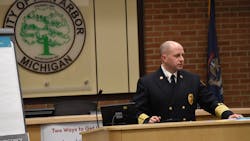MI Fire Chief: Ambulance, not Uber, Will Help Responses
ANN ARBOR, MI—Twenty-three minutes.
That’s how long Ann Arbor firefighters were on the scene with an injured cyclist with a dislocated knee before the man gave up waiting for an ambulance and instead called an Uber to get to the hospital, Fire Chief Mike Kennedy said.
The incident occurred shortly before 7 p.m. Oct. 9 at William and Division streets downtown, while Huron Valley Ambulance vehicles were diverted to higher-priority calls, Kennedy said.
The cyclist was not hit by a car, but lost control of his bicycle and was in stable condition, Kennedy said, indicating firefighters responded to the scene within about four minutes.
The fire chief shared the story with City Council this week to highlight the need for better local ambulance service, proposing the Ann Arbor Fire Department step up to fill the void.
HVA, a nonprofit owned and operated by Emergent Health Partners, provides ambulance service for the Ann Arbor area, but on a weekly basis there are instances of firefighters being dispatched to a scene while HVA has no ambulances available, Kennedy said.
“This is putting us in somewhat of a critical predicament where we could have one of our residents with a life-threatening emergency and us not having the ability to get them to the hospital,” he said.
There were 77 incidents from September through November where city firefighters, who are trained and licensed as emergency medical technicians, were on scene with a patient for more than 10 minutes waiting for an HVA ambulance to arrive, Kennedy said.
The longest wait time was 53 minutes, and the next longest was 42 minutes, he said, adding it’s tying up fire department resources.
The October incident with the cyclist who called Uber is one example of how having a basic-life-support ambulance in the fire department’s fleet would have allowed firefighters to properly transport the patient while HVA dealt with higher priorities, Kennedy said.
He’s now asking City Council to approve the $243,000 purchase of such a vehicle for the downtown fire station in 2020, replacing a light-rescue truck with a new transport-capable ambulance.
Using the same practice as HVA, the fire department would charge cost-recovery fees for transports, and no additional training or staffing would be needed, Kennedy said.
HVA’s standard is to respond to life-threatening emergencies in 10 minutes or less at least 90% of the time, and it’s exceeding that, spokesman Matt Rose said, noting that typically includes patients who are having trouble breathing, experiencing chest pain or are unconscious.
Within the city of Ann Arbor, HVA was on the scene of life-threatening emergencies in 10 minutes or less 93% of the time in November, with an average response time of 7.2 minutes, Rose said.
For calls that weren’t life threatening, HVA was there within 30 minutes 98% of the time, with a 13.3-minute average response time, he said.
Diverting an ambulance to a life-threatening emergency from a non-life-threatening call does occur occasionally, but cases of an ambulance being unavailable are extremely rare, Rose said.
Non-life-threatening emergencies include instances where the patient is considered medically stable, he said.
HVA is continually looking to improve its response times by reevaluating the positions of its ambulances and other innovative ways to use resources, Rose said.
The use of emergency lights and sirens by ambulances is protocol-driven and dictated by the local Medical Control Authority, Rose said, adding the state’s medical director has emphasized the importance of using lights and sirens only when a patient has a life-threatening condition, due to safety risks to the public.
Kennedy said he’s not trying to point the finger at HVA, as there are challenges with emergency medical services nationwide.
“This is not an issue specific to HVA,” he said. “EMS is just an industry where there’s very few people going into it.”
There also may be changes coming to the fire dispatch contract with Emergent Health Partners, Kennedy told council, indicating they’re in negotiations to improve dispatch services, which will rely heavily on staffing increases. That could increase annual costs for fire dispatch services from roughly $117,000 to $200,000, he said.
“We’re currently working with Emergent Health Partners leadership to come up with a better staffing model,” he said.
“Similar to EMS, dispatch is also struggling with hiring dispatchers and it is a nationwide problem.”
———
©2019 MLive.com, Walker, Mich.
Visit MLive.com, Walker, Mich. at www.mlive.com.
Distributed by Tribune Content Agency, LLC.
